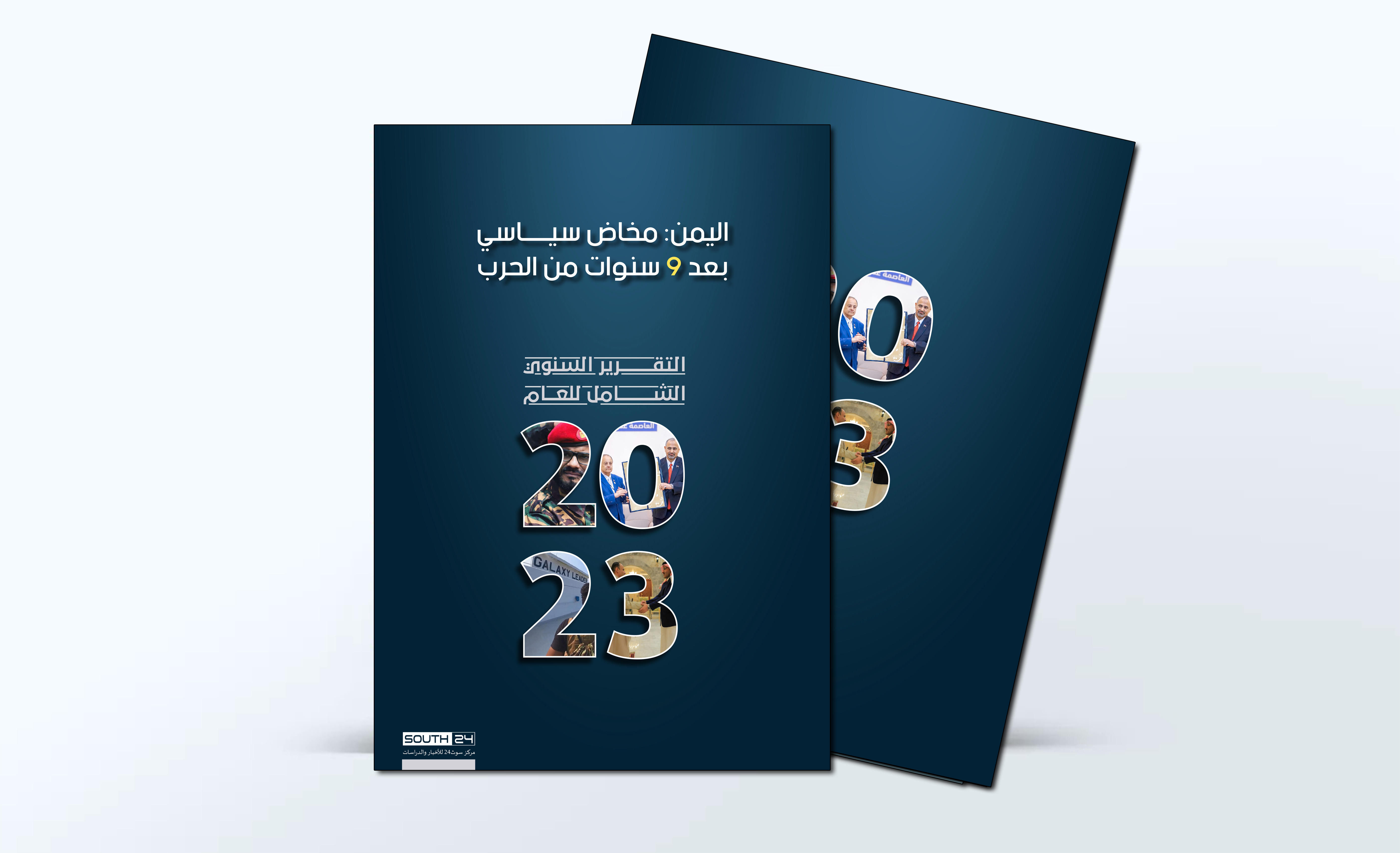
The report cover (South24 Center)
Last updated on: 31-12-2023 at 3 PM Aden Time

South24 | Zurich, Aden
Introduction
The armed conflict in Yemen entered its ninth year in 2023 amid indications about the possibility of achieving a likely final and permanent cease-fire in the country. This follows a series of separate talks between Saudi Arabia and the Houthis. This is in addition to Riyadh’s bilateral discussions with Oman and the Chairman of the Presidential Leadership Council (PLC) Rashad Al-Alimi. Without achieving any decisive progress in its effort to start a comprehensive peace process, the United Nations resumed its efforts to reach a political solution to the Yemen conflict. But it encountered major obstacles due to the complexities of the Yemeni crisis and its regional linkages. In addition, the Houthis sought to diplomatically extract more advantages and enhance and expand their gains on the ground. In particular, the UN succeeded in its efforts in reaching an agreement among the Yemeni parties to exchange war prisoners. In February 2023, Saudi Arabia and the United Nations lifted the inspection mechanism imposed on the Port of Al-Hodeidah, which is now under Houthi control, in a way that has increased the Houthi maritime threats.
The Iran-backed Houthis continue to exert control over the capital Sanaa and large areas in the north and west of Yemen, while the internationally-recognized government and the Southern Transitional Council (STC) still control Aden and other areas in the south and east of the country.
Meanwhile, the ’Southern Consultative Meeting‘, that was held in May with the attendance of dozens of Southern parties in Aden, led to the signing of some historic documents*. This served as a strategic turning point regarding the political movement in South Yemen and reconciliation between the different communities in the South. The meeting led to the expansion of the STC's quota within the Presidential Leadership Council (PLC) - the executive body of Yemen's internationally-recognized government created in April 2022. It is worth mentioning that the STC demands the restoration of South Yemen State. The unprecedented Omani-sponsored mutual visits between the Houthis and Riyadh and the proposed Saudi roadmap to solve the Yemeni crisis have opened the way toward a qualitative transformation in Saudi Arabia’s policies with its regional rivals including Iran. This will have both positive and negative effects on the Yemeni file, according to experts. Meanwhile, speculation continues regarding the disagreements or disputes between Saudi Arabia and the UAE over Yemen. This was reflected in media statements by activists from both countries.
The ongoing international diplomatic efforts for arriving at a political solution to the conflict led to the declaration by UN Envoy to Yemen Hans Grundberg on December 23, that all parties are committed to measures as part of a roadmap, including ceasefire, improving living conditions, paying the salaries of public employees, resuming of oil exports, opening roads and working toward a comprehensive peace process.
In 2023, the military situation in Yemen witnessed a state of strategic immobility without any changes related to the control or making progress on the ground. However, the Houthi attacks on the Southern forces and those affiliated with the government continued in some local fronts including at Al-Dhalea, Yafa, Abyan, Marib, Shabwa, and Taiz. This annual report documents 58 Houthi attacks against the Southern forces during 2023 that led to the killing of 24 soldiers and civilians. Moreover, the Houthis announced that some of their elements were killed but did not identify the dead or provide any details. The year 2023 also witnessed assassination attempts on the Yemeni Defense Minister Mohsen Al-Daeri, the Yemeni Military Chief of Staff Lt. Gen. Sagheer Bin Aziz and the Marib Governor Major General Sultan Al-Arada, with the finger of accusation in every case being pointed at the Houthis as being behind the attempts.
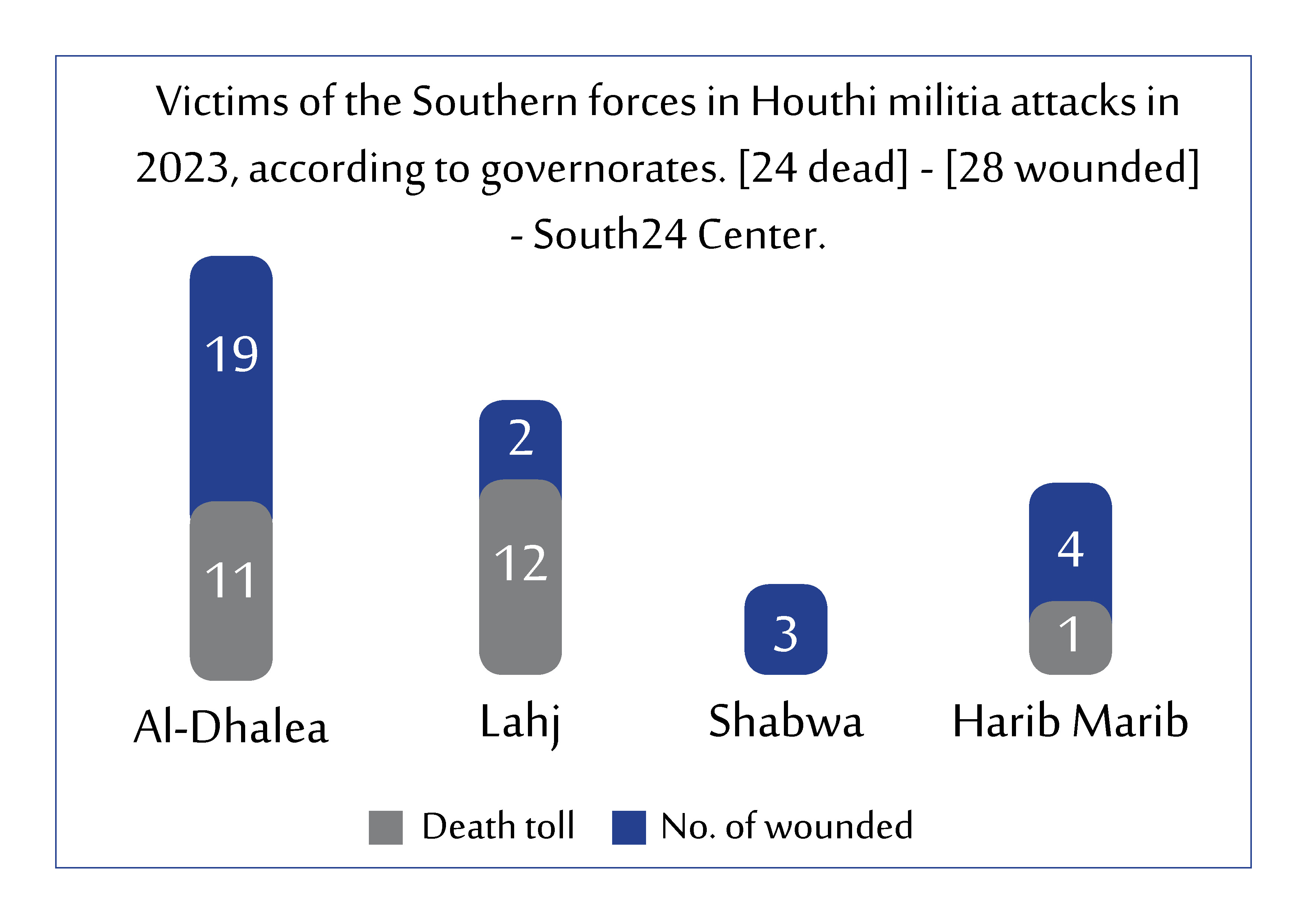
Despite the cessation of the Saudi and Houthi cross-border air attacks since the declaration of the UN-brokered truce in April 2022, instances of limited ground clashes between the Houthis and the Saudi border guards continued to occur, especially in Saada. This led to deaths and injuries of dozens of members from both sides. Additionally, the Houthis launched a major attack on Bahraini forces, south of Saudi Arabia in September, that killed four soldiers and left many others wounded.
Regionally, the Iran-backed Houthi militia have been involved in the ongoing conflict between Israel and Hamas in Gaza. They have expanded their threats against international navigation by seizing and attacking some vessels. This has pushed Washington to establish an international coalition - ’Operation Prosperity Guardian’ - with the participation of 20 countries to protect ships from Houthi attacks. This move has the potential to complicate the peace process in Yemen and expand the regional conflict with Iran. These events have pushed the STC to clearly condemn the Houthi maritime attacks and support the efforts to protect and secure the crucial waterways, most of which are located in South Yemen, especially the busy Strait of Bab al-Mandab and the Gulf of Aden.
The year also saw the Al-Qaeda in the Arabian Peninsula (AQAP) escalate its attacks against the security and military forces in South Yemen during the first three quarters of 2023. However, the attacks were largely diminished during the last quarter. The outfit launched 51 attacks against the Southern forces in Abyan and Shabwa governorates that killed 53 soldiers and officers and left 114 others injured. The list of victims includes the prominent leader of the ’Security Belt‘ in Shabwa, Major General Abdullatif Al-Sayed.

In 2023, the economic condition in Yemen deteriorated as the price of the local currency witnessed record new lows. Moreover, oil and gas exports from the government’s ports have been halted since the November 2022 Houthi air attacks targeting the oil ports in South Yemen. As a result, the government has lost nearly $2 billion till October 2023. Likewise, the problems of electricity, lack of services, and the growing inflation rate have worsened the economic and living crisis suffered by the people. Saudi Arabia also released part of the grants it had announced in 2022, which proved to be a savior for the internationally recognized government that was struggling to cope with the challenges. Despite this, the poverty and unemployment rates largely increased during the year.
At the humanitarian level, Yemen is threatened by epidemics and infectious diseases such as cholera and diphtheria. Tens of thousands of people have been locally displaced even as 95,000 persons have immigrated from the Horn of Africa to Yemen. The humanitarian crisis has piled up due to the lack of international aid projects amid the ongoing Houthi threats against the ports of Aden and South Yemen. More than 21 million Yemenis need help. The restrictions on women and religious minorities in the areas under Houthi control have also continued. The year witnessed violations against journalists in the government-controlled areas. The deadly landmines* killed more than 60 civilians, including children, in some governorates.
Despite all these hardships, there are some signs of hope of finding a political solution to the conflict in Yemen. The warring parties have begun to exchange diplomatic messages. This is probably an indication about their readiness to begin serious negotiations. However, it is still too early to confirm whether the UN-sponsored negotiations will lead to a final political solution of the conflict in Yemen that would take into consideration the main causes in the country such as the South Yemen issue.
This 162-page report highlights the political, military, economic, and humanitarian sides in Yemen by monitoring 577 pieces of news along with their original sources. The report illustrates the prominent events of each axis by using info-graphics and charts that document the main statistics about the entire developments of the year.
Through this annual report, prepared by our team for more than three months, ’South24 Center‘ provides an important news and research reference for the media and interested parties. We don't bear responsibility for the policies adopted by the sources in this report except for those attributed to ’South24 Center‘.
The report was issued on December 26th, in Arabic, and consists of 162 pages and more than 600 news. It can be read or downloaded from here.
The Political Axis
The fast-paced events in Yemen in 2023 are not less important than their precedents over the past years. These events are closely related to most happenings of the previous years, amid the emergence of new paths with their intersected and parallel dimensions and consequences. While the war in Yemen enters its ninth year, the Beijing-sponsored Saudi-Iranian rapprochement arrived at in March, has affected a large section of the Yemeni issue. A prominent outcome of the deal was exemplified by the continuous Saudi-Houthi meetings that were held in the wake of the first public mutual visits between Sanaa and Riyadh since the outbreak of the conflict in Yemen. Oman has been present during the talks, along with the mediation efforts by the UN Special Envoy to Yemen Hans Grundberg. This led to a de-facto truce, based on the one which expired in October 2022. Additionally, Riyadh proposed a roadmap to solve the conflict, comprising three phases. In a recent statement, Grundberg announced that working on the roadmap is underway. He also “welcomed the parties’ dedication to a range of measures including implementing nationwide ceasefire, improving living conditions for the Yemeni people and engaging in inclusive political process under the auspices of the United Nations”.
Significantly, while Saudi Arabia has sought to play a mediator’s role in the talks with the Houthis, it deliberately excluded Yemen’s internationally recognized government from most of the talks with the Iran-backed group. Furthermore, Riyadh has also turned a blind eye to many Houthi violations of the truce on several different fighting fronts, including along its borders with South Yemen. For example, Riyadh did not take a firm stance with regard to the September 2023 attack that targeted Bahraini forces on the Saudi southern border. It merely issued a limited condemnation of Houthi elements. This conclusively highlights that Riyadh at all costs wants to maintain the de-facto truce with the Houthis, in the path toward a peace deal that would put an end to a war that has upset its plans and budget for nine years.
Concurrently, in South Yemen, relentless efforts have been made to bring together the different political actors there. The most prominent event this year was the ’Southern Consultative Meeting" that was inaugurated on May 4 in Aden. This came as a result of more than 200 sub-meetings between different Southern actors, facilitated by the committees of internal and external Southern dialogue, formed by the Southern Transitional Council (STC). This move has led to a big qualitative progress and culminated in a unified joint vision about the project of the South Yemen state. Moreover, the so-called “Southern National Pact” was signed by more than 35 entities and parties in Aden. The STC has also largely restructured its political bodies. Unexpectedly, two members of the Presidential Leadership Council (PLC), Abdulrahman Al-Mahrami and Faraj Al-Bahsani, joined the STC as two deputies of its President, Aidrous Al-Zubaidi. Observers believe that this move enhances the STC at both the political and military levels and underscores the importance of organizing work among the Southern forces. This move has not been welcomed by the Northern Yemeni political parties and probably Saudi Arabia which supports the Islah Party and other factions in the Yemeni official government.
As a response to this Southern political move, the establishment of the “Hadrami National Council” (HNC) was announced in Riyadh in July, amid the presence of some Hadrami political and social figures, with Saudi sponsorship. In late November, the establishment of the HNC’s Presidium was declared. Many Southerners who are against the formation of this entity say the ‘HNC’ was established at the behest of Riyadh and the Yemeni parties whose influence has been reduced following the political power transfer (to the PLC) in April 2022, especially the Islah Party (the Muslim Brotherhood’s Yemeni branch) which is seeking to strengthen its influence again in the oil-rich Hadramout Governorate through local entities.
The Saudi monopoly over its restricted talks with the Houthis has sparked anger among the Southern politicians and others. The Southern parties warned that any bad agreement would restore the Iranian influence in the Southern areas and threaten international navigation. As part of efforts to maintain the de-facto truce and under the pressure of criticism, the last two months of the year witnessed extensive regional and international diplomatic moves to enhance peace efforts in Yemen and push for reaching a solution that would put an end to the conflict. The roadmap, submitted by Riyadh in April 2023, has been the most controversial subject within the Yemeni government in November and December. This is because some of its leaked proposals seek to give the Houthis major concessions at the expense of the substantial oil and gas revenues which are mostly concentrated in South Yemen. This has been met with unequivocal Southern rejection regardless of the STC's response to the Saudi efforts in principle. Even after the UN Envoy’s declaration on December 23, it is still unclear when the details of the roadmap will be officially announced.
Amidst these political developments, the Israeli war on Gaza following the attack launched by Hamas on October 7 and the resultant regional and international polarization has impacted the Yemeni parties and the security in the busy Strait of Bab al-Mandab. This comes amid international warnings that the escalating Houthi attacks in the Red Sea and the Gulf can destroy the opportunities for peace in the country. The attacks carried out by the Iran-backed group, under the pretext of targeting Israeli ships as a response to the war on Gaza, have led to new military developments that compel the forces affiliated with the official Yemeni government to deal with Houthis politically and militarily. Although the Yemeni government denies its participation in any international coalition in this regard, the STC stressed that its military forces are ready to play a pivotal role to secure the strategic international maritime corridor along with regional and international partners.
It can be said that 2024 could see the birth of a political agreement after serious hardships. This may actually end the conflict, which is the longest ever in the region’s modern history. Conversely, it may also destroy the chances for peace and lead to the return of military operations, especially amid Iran’s clear involvement in the escalating conflict in the Red Sea and Bab al-Mandab.
The ’political axis‘ highlights the most prominent political events in Yemen during 2023 using a chronological sequence which points out how they began, how they have transformed and the extent of their future impact on Yemen over the next year.
The military and security axis
Despite the military de-escalation between the Yemeni parties during 2023, this year wasn’t a mild one. Several Southern and Northern fronts witnessed hostile acts that threatened to rekindle the war. Dozens of civilians and soldiers were killed and injured throughout the year. In particular, 2023 was remarkably a security year, especially in South Yemen. The AQAP heavily escalated its operations against the Southern forces affiliated with the STC in Abyan and Shabwa at an unprecedented pace. The AQAP’s aim was to attempt to reverse the outcomes of the anti-terror operations - ’Arrows of the East‘ and ’Arrows of the South’ launched by the Southern forces – that inflicted severe defeat on the extremist organization within its strongholds in 2022.
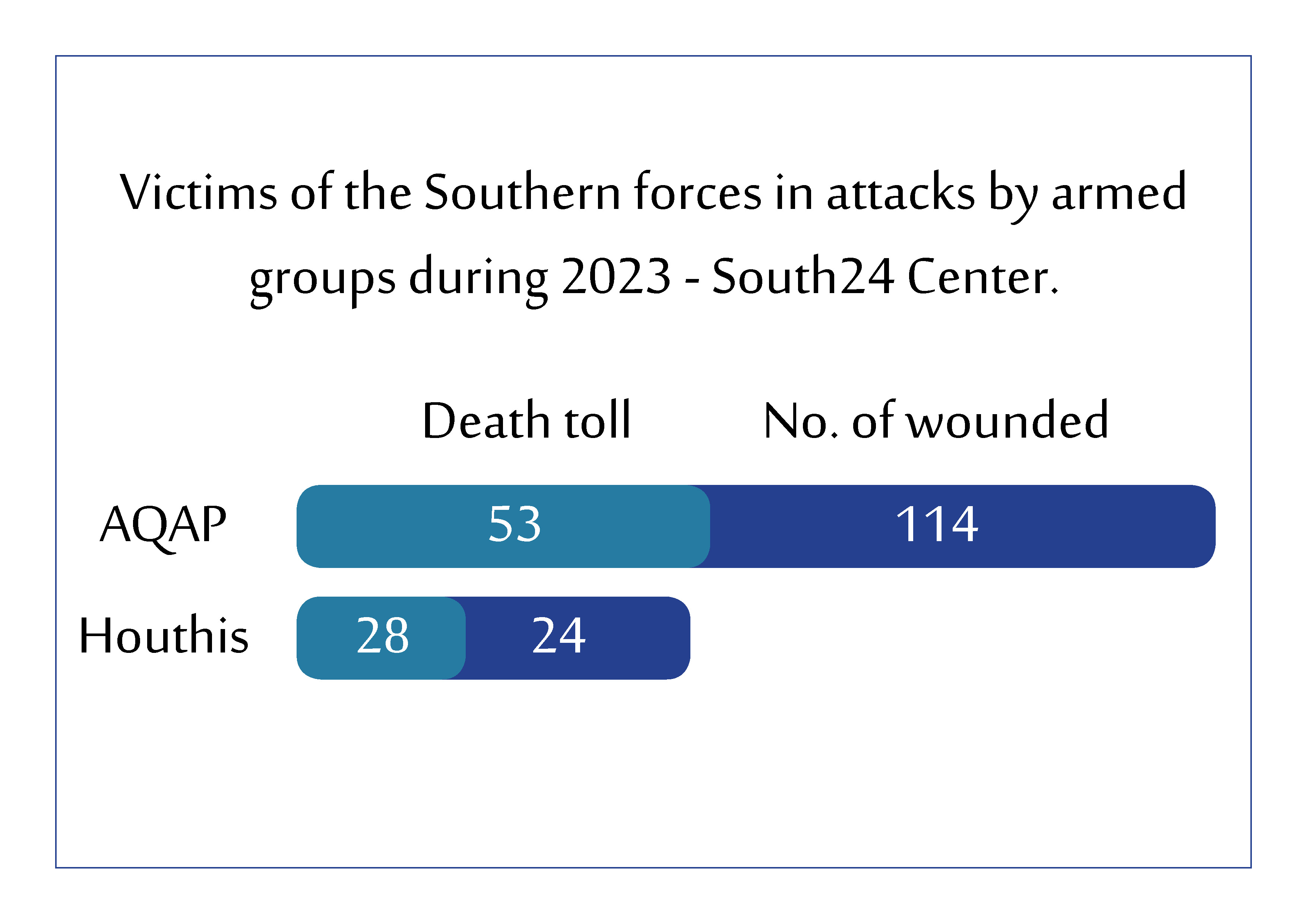
Since the beginning of the year, ’South24 Center‘ documented about 51 AQAP attacks on the Southern forces, 28 of which were in Abyan and 23 in Shabwa. Most of the attacks focused on Mudiya in Abyan and Al-Masaniah in Al-Said District in Shabwa. The attacks killed about 53 soldiers and officers and injured 114 others from military units affiliated with the Southern forces, including ’the Security Belt‘, the ’Back and Support Brigades‘ and the ’Shabwa Defense Forces‘. The number of victims in Abyan was 39 dead and 78 wounded. In Shabwa, 14 were killed and 36 injured. These attacks were launched simultaneously with some speeches being delivered by AQAP leader Khaled Batarfi.
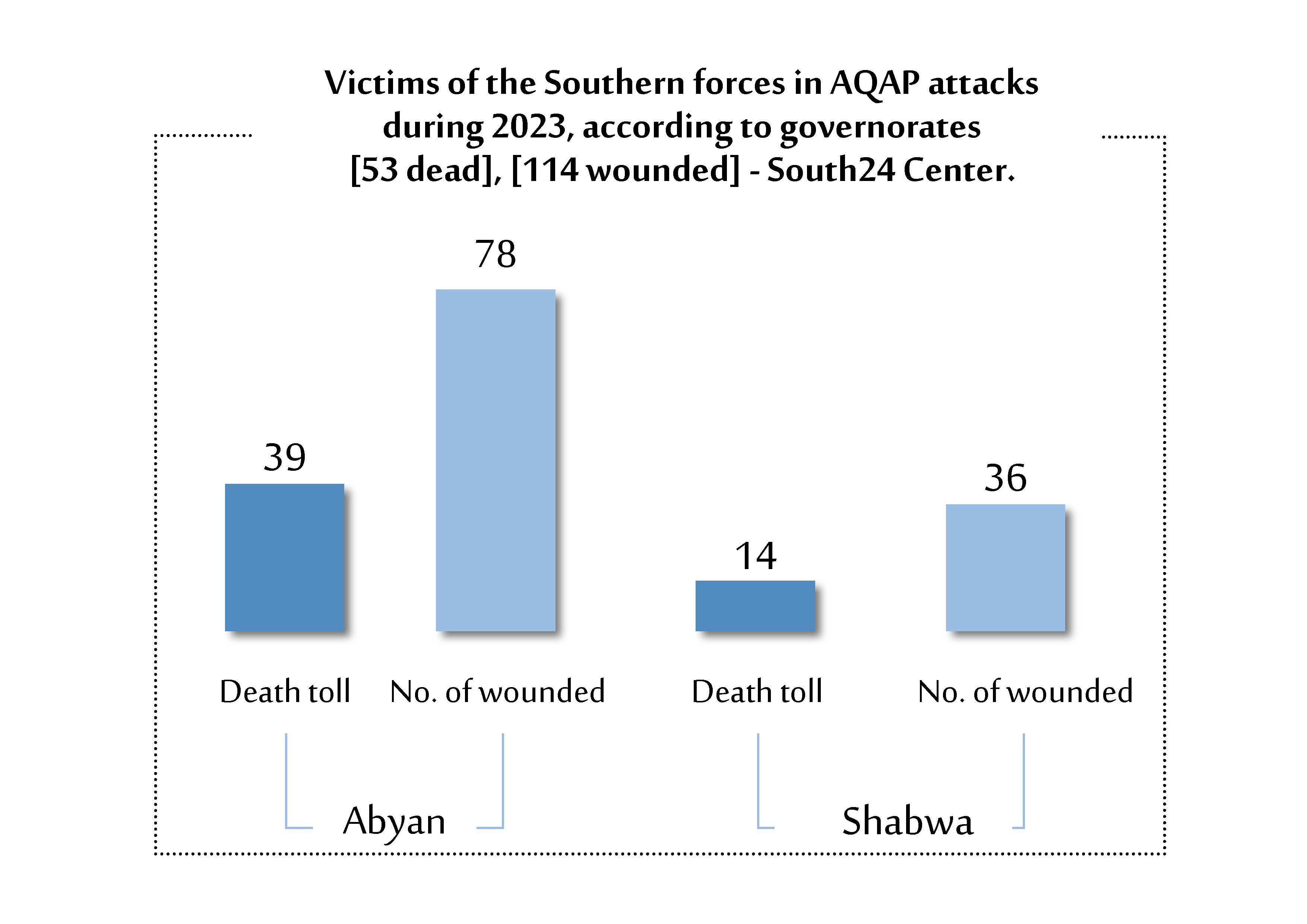
June witnessed the largest number of AQAP attacks (11 operations) against the Southern forces, followed by May (nine operations), January, July and August (five each), February and March (eight attacks), and eight attacks during the remaining months. Explosive devices were AQAP’s favorite weapon used to carry out the attacks. This came as part of the “attrition and traps'' stage announced by the organization in late 2022 under their so-called ’Arrows of the Righteousness‘ as a counter-offensive to the Southern forces. It used explosive devices 26 times. Notably, the AQAP launched nine drone attacks which were its second most used weapon. This has happened for the first time in AQAP's history. The organization carried out eight attacks using firearms during direct clashes, in addition to four mortar shell attacks, two landmine attacks, two car bomb attacks and one motorcycle bomb attack.
On August 10, Security Belt Commander in Abyan Brigadier General Abdullatif Al-Sayed was assassinated by an AQAP explosive device. He was the most prominent military leader killed by AQAP besides Abdulrahim Al-Maakar, Salem Salaan, Abdullah Saad, Meshel Al-Alyani and others. AQAP failed in its attempt to assassinate the Commander of the Special Forces in Aden, Lahj, Abyan and Al-Dhalea, Major General Fadl Baesh in a car bomb attack in early October.

On the other hand, AQAP lost some of its prominent elements, who the outfit described as “leaders” such as ’Abu Al-Qaqaa Al-Kazimi‘ and “Abu Talha Al-Baidani”. This is in addition to an unknown number of AQAP members who were killed during the attacks. Moreover, the Southern forces completed their mission to establish control over important mountain ranges in Abyan including ’Jinan Heights‘, ’Wadi Al-Rafd‘ in Mudiya District and ’Wadi Al-Khayala‘ in Al-Mahfad District. The Southern forces also dismantled the networks of mines and explosive devices in the area.
During 2023, the Iran-backed Houthi militia carried out 58 attacks against the Southern forces, including 34 in Al-Dhalea alone. Nearly 24 attacks were launched in Lahj Governorate on the fronts of Yafa, Kirsh and Tur Al-Bahah. Furthermore, the militia carried out six attacks against the Southern forces in Shabwa and Abyan and around four attacks in Harib District in Marib where the Southern ’Giants Brigades‘ were deployed. This is in addition to other attacks in Taiz and Saada.
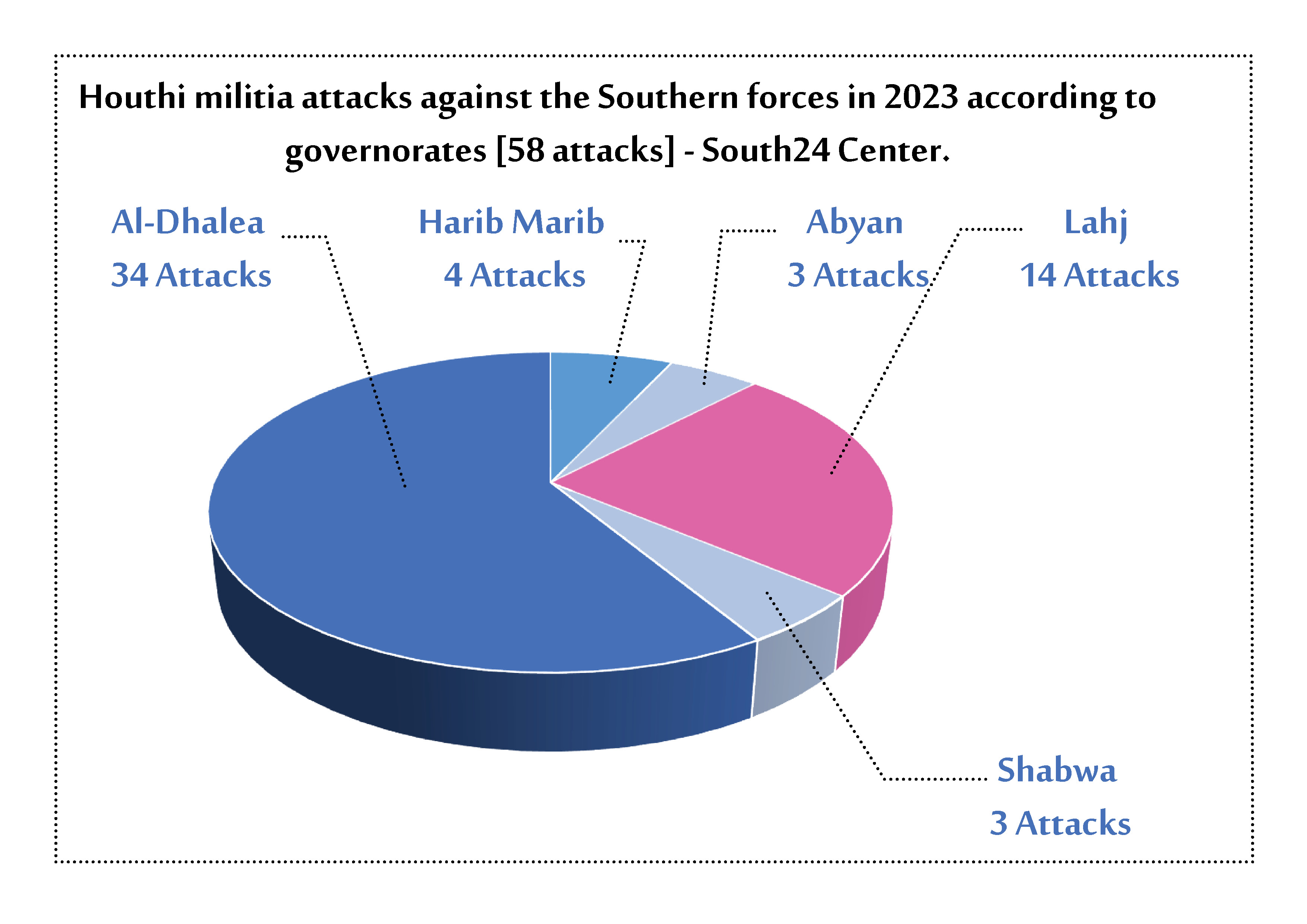
The Houthi attacks killed 24 Southern soldiers and left 28 others injured: 12 of the dead soldiers and two of the wounded were in Lahj; 11 dead and 19 wounded were in Al-Dhalea, while one was killed and four were injured in Harib in Marib. Moreover, the attacks in Shabwa left three soldiers injured. On the other hand, the Houthi militia lost dozens of fighters during these attacks. The Houthis are believed to be responsible for the bloody assassination attempts that targeted Yemeni Defense Minister Lt General Mohsen Al-Daeri, Taiz Governor and the Yemeni Chief of Staff Lt General Sagheer bin Aziz. Moreover, the militias are accused of sending a cell from Sanaa to assassinate Marib Governor and PLC Member Major General Sultan Al-Arada. Government officials suggested that the Houthis were also behind an assassination attempt on Sagheer bin Aziz on the road between Al-Abr and Marib in November.
Officers affiliated with the government were killed in Taiz and Marib. The Southern and government security forces in the two governorates of Taiz and Marib announced the arrest of several Houthi cells. Some elements of these cells also tried to enter Aden. This happened concurrently with the seizing of Houthi cells affiliated with the Commander of the Yemeni Transportation Brigade, Brigadier General Amjad Khaled, who is based in Al-Turbah in Yemen and the no 1 wanted person in Aden. He is accused of planning assassination attacks and bloody explosions in Aden over the past years. In November this year, audio and video recordings revealed Amjad Khaled's involvement in instructing, planning and supervising operations to assassinate security leaders affiliated with the STC.
The parties continued their efforts to enhance their military capabilities. New brigades of the Southern forces were formed at the beginning of this year. Some batches affiliated with the ’Southern Giants Brigades‘ and the government forces in Marib graduated. The Houthi militia demonstrated their military power through military parades. They also exploited the latest events in Gaza (the Israel-Hamas war) to mobilize thousands of tribal gunmen.
In a prominent regional development, the Houthi militia opened the door for maritime conflict in the international waters surrounding Yemen after launching air and maritime attacks reportedly targeting Israel. By December 24 this year, the Houthis had attacked 17 commercial and military ships in the Red Sea and Bab al-Mandab strait. This has partially paralyzed the global trade and led to the subsequent formation of an international military coalition, affiliated with the Joint Task Force (153), led by the United States, to protect international navigation. There are concerns that this may turn into a regional military conflict, in which Iran will be involved.
Furthermore, one of the most prominent military events was the decision of PLC Chairman Rashad Al-Alimi in early 2023 to grant official status to the Nation Shield Forces, established by Saudi Arabia. Although these mostly-Salafi forces were seen as an attempt to counter the STC's influence, their leader Brigadier General Bashir Al-Madrabi attended a large meeting for the Southern military commanders in November in Aden, headed by Major General Aidrous Al-Zubaidi. This was probably an attempt to thwart these doubts.
The Economic Axis
In general, 2023 with its economic aspects witnessed a remarkable turmoil in the areas controlled by the internationally-recognized government (IRG) in South Yemen. This was illustrated in the decline of the local currency and the failure of the Central Bank of Yemen (CBY) in Aden and its economic hubs to make any positive impact on the national economy or to stop the sharp deflation due to the war and its repercussions. The powerlessness of the state institutions, the slow pace of economic reforms coupled with poor governance, and the need to end corruption, have been accompanied by the cessation of oil exports from Shabwa and Hadramout in South Yemen since the end of the last year as a result of the Houthi attacks and threats. This has burgeoned into a massive economic crisis that has impacted the performance of the government and the local authorities.
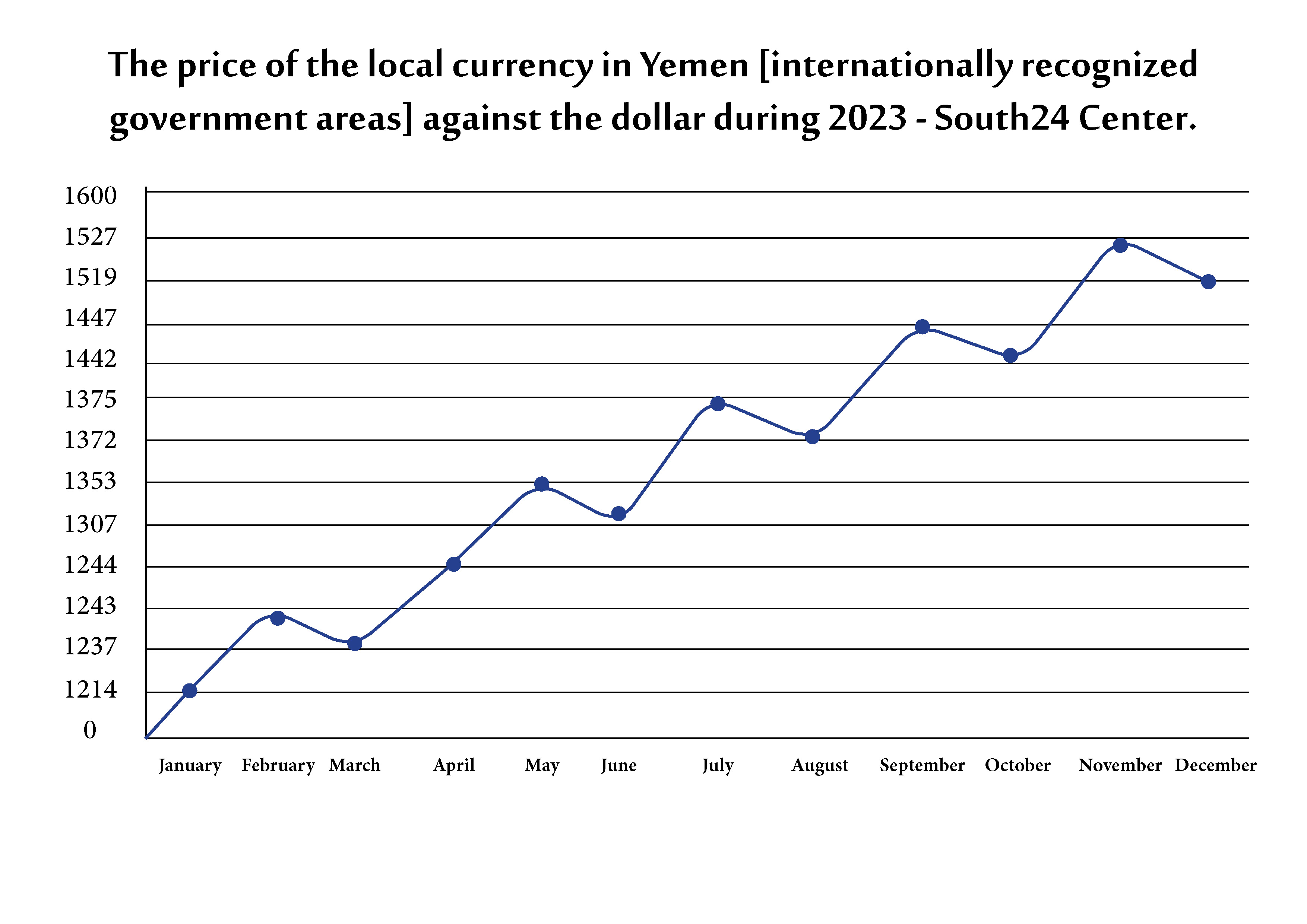
The joint Saudi-Emirati $2 billion grant, although it was announced in April 2022, has not been so far completely available. However, the Gulf support contributed in covering some of the economic needs such as electricity and fuel in Aden and the other governorates. Moreover, several projects were achieved by the ’Saudi Development and Reconstruction Program for Yemen’ – to improve living conditions in Yemen by implementing development projects, and the ‘King Salman Humanitarian Aid and Relief Center’.
Meanwhile, the economy in North Yemen, which is under Houthi control, continues to be subjected to unilateral measures and kept separate from South Yemen. The ongoing use of old versions of the local currency in North Yemen has caused a big gap in the value of the Yemeni riyal between Aden and Sanaa, with its price in Sanaa being nearly three times higher. However, the prices of food and commercial products don’t differ much in North and South Yemen. The high royalties and taxes imposed by the Houthis on people have compounded their suffering. Many teachers and civil service employees within the Houthi areas still don’t receive their salaries.
In spite of the economic deterioration, some achievements were attained. For example, the Central Bank of Yemen in Aden has stopped its reliance on printing of the local currency without having a foreign currency cover in 2022 and 2023 respectively and carried out 41 auctions till 31 October. Although the Yemeni riyal witnessed growing inflation rate, especially in the second half of the year, where the US dollar against the Yemeni riyal reached the level of 1,307 for the first time since the beginning of 2023, the currency witnessed relative stability over the first months. By November, the inflation reached its peak when the price of a US dollar against the Yemeni riyal reached 1,500 in Aden while it was 514 in Sanaa (which is under Houthi control).
It can be said that services and living standards have been among the lowest priorities of the parties in Yemen. For example, the daily rate of power outage in Aden was 20 hours during the hot season many times. Other Yemeni sectors, such as education and health, continue to be the worst in the world.
The donors delivered only $1.2 billion of a total of $4.3 billion demanded by the United Nations to fund the ’Humanitarian Response Plan‘ in Yemen in 2023 in February. By September, the repercussions of the lack of finance reached their peak when the ’World Food Programme‘ announced it will be obliged to make additional reductions to its aid delivered to millions of people across Yemen by the end of September due to a “sharp funding crisis” of its humanitarian operations. In December, it announced the cessation of its food aid program in the Houthi areas due to the poor financial status and the failure to reach an agreement with the authorities to carry out a smaller program to the most vulnerable families in a way that matches the available resources.
The direct financial and food aid delivered by the effective international and local organization partners contributed to alleviating the humanitarian crisis in the country. In December, the United Nations said that the humanitarian response plan in Yemen for the next year 2024 requires about $2.8 billion.
Notably in 2023, the Houthis in North Yemen got access to new economic resources at the expense of the Yemeni government, with the most important takeover of the Port of Al-Hodeidah, a key port on the Red Sea coast. The port now receives the biggest share of the commercial shipping to Yemen. This has even surpassed the shipping commerce to the strategic Southern Port of Aden for the first time. The Houthi actions such as threatening the business companies and setting up of customs checkpoints for commodities coming from the Port of Aden have obviously enhanced the attractiveness of the Port of Al-Hodeidah. Along with the cessation of oil exports (due to Houthi threats and attacks on Southern ports), the IRG lost billions of riyals, including revenue related to customs and sale of domestic gas in the Houthi areas. This happened after the Sanaa government began to import gas from abroad through the Port of Al-Hodeidah.
A report prepared by the UN Security Council’s ’Team of Experts‘ interested in Yemen estimates that the IRG lost $2 billion since the cessation of oil exports. As a result of the entanglement of the economic and political issues among the Yemeni parties, there are talks about an imminent economic agreement that may be signed soon. The draft agreement is called “the roadmap”. According to informed sources, the first stage of the roadmap includes the resumption of oil exports, paying the employees’ salaries across Yemen, the complete opening of the Port of Al-Hodeidah and the Sanaa International Airport as well as many other economic measures, many of which are favorable to the Houthis.
The Humanitarian Axis
The war in Yemen is about to complete nine years. Throughout 2023, the humanitarian aspect wasn’t less tragic than the aforementioned axes. The humanitarian crisis, resulting from the war’s repercussions, has further aggravated. Statistics, issued by the specialist international organizations in 2023, highlight the magnitude of the Yemeni humanitarian crisis – the worst such disaster in the world. 25% of Yemenis need psychological treatment, according to the ’United Nations Population Fund‘. The living conditions of 17 million Yemenis have capsized and they are on the verge of starvation, according to the ’United Nations Office for the Coordination of Humanitarian Affairs (OCHA)’.
Moreover, 21.6 million of a total of 31.5 million people in Yemen are in dire need of humanitarian and protection services. About 12.9 million people desperately need urgent health care, according to a 2023 report by the ’World Health Organization (WHO)’. Throughout 2023, epidemics reemerged in Yemen even though they had disappeared in the world many decades ago. Between January and October, ’WHO‘ said that more than 5,000 cases of cholera were documented in Yemen.
Additionally, ’WHO‘ announced that diphtheria cases in Yemen increased by 57% in 2023 in comparison to the rates in 2021 and 2022. Over this year, 1,671 cases of suspected diphtheria were reported while the death cases related to it stood at 109. In May, a UNICEF report said that six million children in Yemen are one step away from famine and that more than 11 million children in Yemen need urgent humanitarian aid, including 2.2 million who suffer from acute malnutrition.
Despite the economic and security situation in Yemen not being much better than in Ethiopia, Somalia, and the Horn of Africa's states in general, the flow of immigrants to the country continues. The ’International Organization for Migration (IOM)’ said that nearly 95,000 African immigrants entered Yemen in 2023 between January and November. It is the highest immigration rate documented over the past four years. This is related to the fact that Yemen is considered a transit point for tens of thousands of Africans who aspire to enter Saudi Arabia and other Gulf nations surrounding the country.
In August 2023, ’Human Rights Watch‘ blamed Saudi Arabia for the death of many immigrants, mostly Africans, during their attempt to cross the Saudi-Yemeni borders. However, Riyadh denied these accusations.
Although the pace of fighting among the Yemeni parties has remarkably decreased in 2023 due to “the de-escalation stage” following political and diplomatic efforts, some 6,460 families, comprising 35,575 people, were displaced between January and October. Marib and Shabwa witnessed the highest numbers of displaced persons.
Till November 2023, the landmines and war remnants killed nearly 69 people and injured 85 in Al-Hodeidah alone, according to the ’UN Mission to Support the Hodeidah Agreement (UNMHA)’. Many victims were children and women.
During the war, two humanitarian officials lost their lives -- one of them being the head of the World Food Programme in Taiz, Moayad Hamidi, a Jordanian citizen, who was killed by gunmen in July. The circumstances of the murder are still vague and the culprits haven't been revealed yet. Taiz’s security authorities, affiliated with the Yemeni government, announced that they had detained some suspected persons. In October, Hisham Al-Hakimi, the security official who worked for the ’Save the Children‘ organization, died inside a Houthi prison in Sanaa. (The aid agency had suspended its program for 10 days in the northern part of Yemen following the unexplained death of Safety and Security Director Hisham Al-Hakimi, 44, a father of four, who was detained on 9 September. His funeral was held on 29 October.)
Authorities in Marib, affiliated with the Yemeni government, continued their violations against journalists. On June, 5 arrest warrants were issued against five journalists. For more than a year, the Southern forces, affiliated with the Southern Transitional Council (STC), continue to detain activist Ahmed Maher in Aden. The security bodies accused the activist of belonging to a military group responsible for bloody assassinations and explosions in Aden as well as holding a military rank. His family has denied these accusations and demanded that the case be brought to trial.
By mid-July 2023, the central city of Taiz, which has the largest population in Yemen, completed 3,000 days of being under siege due to the Houthi closure of roads.
On the other hand, some successes were achieved on the humanitarian side. The deal to exchange war prisoners, between Saudi Arabia and the internationally-recognized government on one hand and the Houthis on the other, was the most prominent achievement. On April 17, the ’International Committee of the Red Cross‘ confirmed the release of 973 former prisoners belonging to the warring parties in Yemen. The list includes former Yemeni Defense Minister Major General Mahmoud Al-Subaihi. Moreover, 104 Houthi prisoners were voluntarily released by Saudi Arabia in a unilateral step.
The “mahram” restrictions imposed by the Houthis against women's freedom to travel entered the second year in a row. This has increased the critical voices that demand revoking these restrictions on Yemeni women within the Houthi areas and not undermining women’s rights and freedoms. At least one Yemeni female activist was sentenced to death by judicial authorities affiliated with the Houthis.
(* The Southern National Pact (SNP), which was signed, states that the “South issue is a land and human issue …. Its representation in the settlement process under the auspices of the United Nations must be within an independent framework.” The Houthis reacted to it by describing the SNP as a “coup against the Republic of Yemen”.)
(*According to the International Committee of the Red Cross, Yemen has one of the world's highest rates of contamination with landmines and other deadly explosives. Experts estimate that at least one million mines have been planted during Yemen's years of turmoil.)
- South24 Center for News and Studies
- To download the Arabic annual report in PDF format (click here)